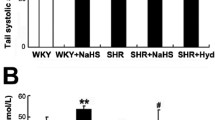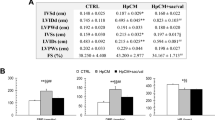Abstract
The aim of the study was to evaluate the clinical efficacy of hydrogen sulfide (H2S) treatment on the endothelin-induced cardiac hypertrophy. Sixty-four adult male rats, weighing from 180 to 200 g, were randomly divided into four groups: ten in normal group, ten in sham group, 44 in model group established by inducing the myocardial hypertrophy with endothelin. The myocardial hypertrophy model rats were randomly divided into two groups: 22 in the simple myocardial hypertrophy model group and 22 in the H2S treatment group. Rats in normal group were given 2 ml pure water by gavage per day, those in the sham group and simple cardiac hypertrophy model group were given 2 ml of saline by gavage per day, and rats in the pure cardiac hypertrophy with H2S treatment were given intraperitoneal injections of 2 ml NaHS saline per day for a period of 4 weeks. Left ventricular mass index, myocyte hypertrophy, volume fraction of myocardial interstitial collagen, myocardial hydroxyproline content and other indicators of cardiac hypertrophy were observed after 4 weeks. (1) There were significant differences on the ventricular mass between the treatment group and the cardiac hypertrophy group: The left ventricular mass decreased 21.4 % and the left ventricular mass index decreased 5.97 % (P < 0.05; (2) the smallest cardiomyocytes diameter and cardiomyocytes cross-sectional area decreased 12.5 and 10.8 %, respectively (P < 0.05) in the treatment group compared to the cardiac hypertrophy group; (3) the volume fraction of myocardial interstitial collagen and the myocardial hydroxyproline content decreased 22.3 and 31.3 % in treatment group compared with the cardiac hypertrophy group, respectively (P < 0.05). H2S had a good clinical efficacy in reducing left ventricular mass fraction and myocardial collagen levels, improving myocardial hypertrophy and decrease myocardial fibrosis. It is worthy for further clinical studies.

Similar content being viewed by others
References
Tong, L. I. U., Yun, G. A. O., Yu-long, G. A. O., et al. (2012). Tacrolimus-related hypertrophic cardiomyopathy in an adult cardiac transplant patient. Chinese Medical Journal (English), 7, 1352–1354.
Zhou, F., Zhong, W., Xue, J., et al. (2012). Reduction of rat cardiac hypertrophy by osthol is related to regulation of cardiac oxidative stress and lipid metabolism. Lipids, 47(10), 987–994.
Szabo, G., Veres, G., Radovits, T., et al. (2011). Cardioprotective effects of hydrogen sulfide. Nitric Oxide, 25(2), 201–210.
Olson, K. R., & Whitfield, N. L. (2010). Hydrogen sulfide and oxygen sensing in the cardiovascular system. Antioxidants & Redox Signaling, 12(10), 1219–1234.
Elsey, D. J., Fowkes, R. C., & Baxter, G. F. (2010). Regulation of cardiovascular cell function by hydrogen sulfide (H2S). Cell Biochemistry and Function, 28(2), 95–106.
Hasan, M. A., Lee, S.-L., Kim, D.-H., et al. (2012). Automatic evaluation of cardiac hypertrophy using cardiothoracic area ratio in chest radiograph images. Computer Methods and Programs in Biomedicine, 105(2), 95–108.
Meng, R., Pei, Z., Zhang, A., et al. (2011). AMPK activation enhances PPARα activity to inhibit cardiac hypertrophy via ERK1/2 MAPK signaling pathway. Archives of Biochemistry and Biophysics, 511(1/2), 1–7.
Errami, M., Tassa, A. T., Galindo, C. L., et al. (2010). Carbamazepine alone and in combination with doxycycline attenuates isoproterenol-induced cardiac hypertrophy. Heart International, 5(1), e7.
Chang-qing, T. O. N. G., Yao, D. I., Zi-quan, L. I. U., et al. (2007). Effect of yiqi huoxue recipe on cardiac function and ultrastructure in regression of pressure overload-induced myocardial hypertrophy in rats. Chinese Journal of Integrative Medicine (in English), 13(4), 291–296.
Feng, J., & Zheng, Z. (2008). Effect of sodium tanshinone II a sulfonate on cardiac myocyte hypertrophy and its underlying mechanism. Chinese Journal of Integrative Medicine (in English), 14(3), 197–201.
Li, Y. J., Cui, W., Tian, Z. J., et al. (2004). Crosstalk between ERK1/2 and STAT3 in the modulation of cardiomyocyte hypertrophy induced by cardiotrophin-1. Chinese Medical Journal (English), 117(8), 1135–1142.
Balakumar, P., & Singh, M. (2011). The possible role of TNF-alpha in physiological and pathophysiological cardiac hypertrophy in rats. Iranian Journal of Pharmacology and Therapeutics, 4(2), 138–142.
Conflict of interest
The authors have no conflicts of interest to declare.
Author information
Authors and Affiliations
Corresponding author
Rights and permissions
About this article
Cite this article
Yang, F., Liu, Z., Wang, Y. et al. Hydrogen Sulfide Endothelin-Induced Myocardial Hypertrophy in Rats and the Mechanism Involved. Cell Biochem Biophys 70, 1683–1686 (2014). https://doi.org/10.1007/s12013-014-0113-3
Published:
Issue Date:
DOI: https://doi.org/10.1007/s12013-014-0113-3




